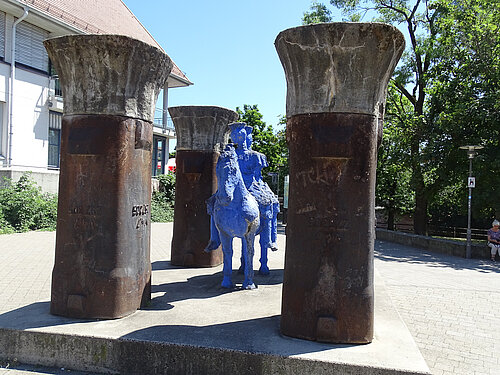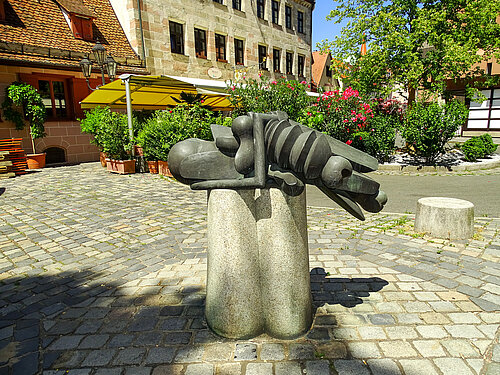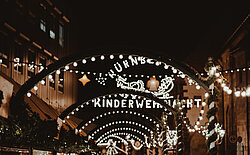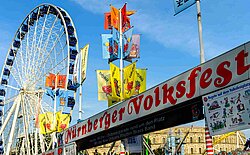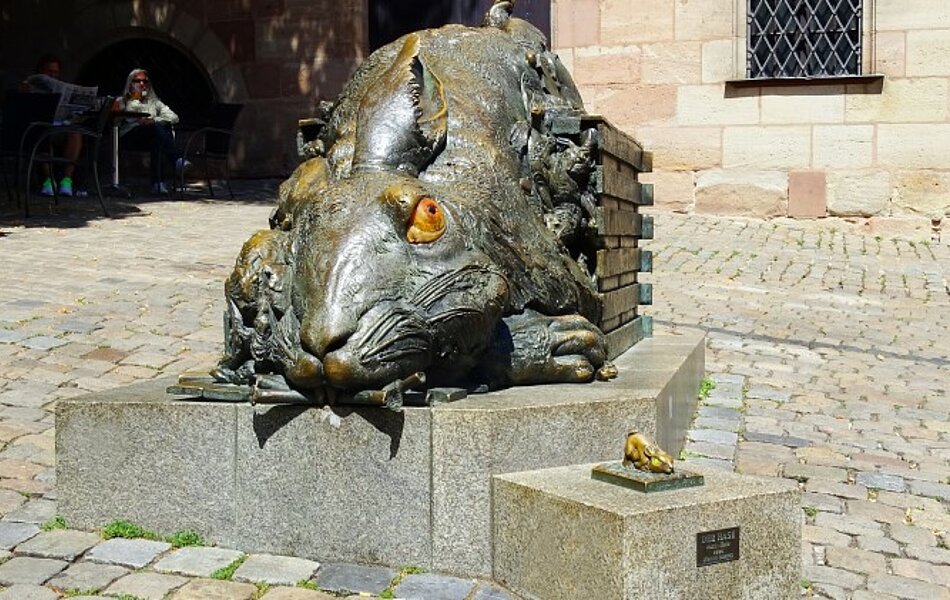
Take the time to drift away for the day. Enjoy Nuremberg with all of its artistic facets.
1Art in public was and still is a popular topic in Nuremberg. In addition to the classic figures of houses and saints, we find many examples of contemporary art within the city centre.
Especially in 1971, the Symposium Urbanum added many sculptures, which now decorate – sometimes more, sometimes less conspicuously – the city of Nuremberg.
We leave the hotel Victoria and head towards the inner city to the left. On the left side, at the Hallplatz, we see the Central Monument Escape and Explusion of 1945 which was created by Joachim Bandau. The Freestate Bavaria built this monument in 1999.
2At the corner of Hallplatz/Pfannenschmidgasse we visit the symmetrical figure, which was built by Hajime Togashi in 1971. This Japanese artist made this piece of art at the main market out of a red granite block, weighing around two tons. The artwork appeals especially through its strict, clear form.
3A few steps further along, we get to the stone gearwheel, which was created by the Polish artist Marian Bogusz in 1971 out of a Waldstein Granite block. It represents the flow of movement.
4Wandering to the Kornmarkt, in front of the Germanic National Museum, we find The Warrior, which was shaped by Marino Marini in the early 60s. The sculpture is a highly abstracted form of an equestrian monument, which geometric shapes and rough surfaces show pain and suffering.
5In between Kornmarkt and Karthäusergasse a ‘Stelenweg’ extends, also known as the Street of Human Rights, by Dani Karavan. In 1993, the Outer Sculpture, which decorates the facade of the Germanic National Museum, was inaugurated. It is not only art that is beautiful here, but also the message for respecting all human rights.
6The corner of Zirkelschmidgasse/Pfeifergasse hosts a small but expressive sculpture Insect (1984) by Max Söllner. Various pens, balls, beads and screws were compacted to an amorphous form, which reminds us of different insect species.
7At the Weißer Turm, also known as White Tower, the controversial artistic fountain "Das Ehekarusell", the Marriage Roundabout, or Hans-Sachs-Brunnen by Jürgen Weber immediately steals our attention. The tale being told by this piece of art reflects a poem by Hans Sachs called ‘Das bittersüße eh’liche Leben’ (The Bittersweet Life of Marriage).
8The sculpture Welthandel (1972), meaning “world trade”, at Kaiserstrasse/Köpfleinsberg uses its very own form-language as well, as the artist Hella Rosner-Böhnlein reduces forms to its symbolical meanings. Five stylized figures facing each other with their backs, connected by many smaller figures forming a ring with a globe resting in its middle. Looking at the title of this creation, we can deduct that the bigger figures resemble the five continents which are connected through global trade.
9At the Trödelmarkt, the flea market, the Dancing Farmer Couple (1980) by Waldemar Grzimek awaits us. This work is based on a Dürer motif and shows a folksy representation of the time.
10We cross the main market and feel the black, Swedish granite of the Prantlstein sculpture. Karl Prantl was one of the responsibles for the realization of the Symposium Urbanum in 1971 and he hoped that with his art he would be able to create a place for people to meet at.
11The Rabbit – a tribute to Dürer, by Jürgen Goertz (1984) can be found at the Tiergärtnertorplatz. Bigger than life-size, the animal before us swells from a too small box, little rabbits gushing from its flank. It is eating nails and from under its monstrous paw peeks a piece of a human foot. Does the artist persiflage Dürer’s original or is this him confidently confronting renaissance and modernism?
12Two worthwhile detours are waiting for us behind the city wall: on the left side at the Neutorgraben we find, on a spot of greenery between the street and the pavement, a sculpture by Maciej Szankowski Stabile o.T. (1971)
13A brown, defined set of steel unfolds before our eyes with an effect similar to a folded origami figure made of paper and reminds us of the form-language of the works of Picasso post-war. On the right side, at the Maxtor, the Die Kauernde by Wilhelm Uhlig, an artist living and working in Nuremberg, is waiting for us to be amazed.
14We return to the river Pegnitz and island Schütt once again and here we find the Blaue Reiter, Blue Horseman, by Johannes Brus at the Andrej-Sacharow-Platz (1993).
15At last, at the Gewerbemuseumsplatz, we view the large disc, Grande Disco (1971), by the Italian artist Arnaldo Pomodoro. The once closed disc seems to have been broken violently and now shows its inherent chaos.
This is only a fraction of public art in our city. A selection which leads us to the most beautiful places in Nuremberg.
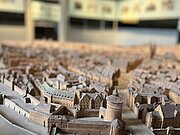
Impressions
Further information
Approximate walking time: 4h
 Neue Infos für Ihren Urlaub – folgen Sie uns auf Instagram
Neue Infos für Ihren Urlaub – folgen Sie uns auf Instagram
